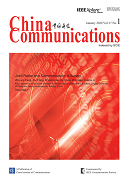COMMUNICATIONS THEORIES & SYSTEMS
Qian Sun, Lin Tian, Yiqing Zhou, Jinglin Shi, Zongshuai Zhang
2020, 17(1): 28-41.
In the 5th generation (5G) wireless communication networks, network slicing emerges where network operators (NPs) form isolated logical slices by the same cellular network infrastructure and spectrum resource. In coverage regions of access points (APs) shared by slices, device to device (D2D) communication can occur among different slices, i.e., one device acts as D2D relay for another device serving by a different slice, which is defined as slice cooperation in this paper. Since selfish slices will not help other slices by cooperation voluntarily and unconditionally, this paper designs a novel resource allocation scheme to stimulate slice cooperation. The main idea is to encourage slice to perform cooperation for other slices by rewarding it with higher throughput. The proposed incentive scheme for slice cooperation is formulated by an optimal problem, where cooperative activities are introduced to the objective function. Since optimal solutions of the formulated problem are long term statistics, though can be obtained, a practical online slice scheduling algorithm is designed, which can obtain optimal solutions of the formulated maximal problem. Lastly, the throughput isolation indexes are defined to evaluate isolation performance of slice. According to simulation results, the proposed incentive scheme for slice cooperation can stimulate slice cooperation effectively, and the isolation of slice is also simulated and discussed.
